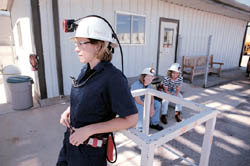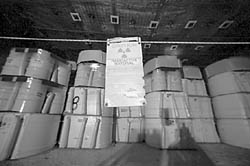 |
 |
||
July 06, 1999Nuclear waste site still hot issueWIPP critics unswayed months after disposal begins in New MexicoBy Greg Harman EDDY COUNTY, N.M. — In the engineered caverns of the Salado salt formation half a mile beneath the New Mexico desert, federal employees are burying military-generated radioactive waste. They hope that over time the 70-mile block of salt will entomb these barrels and boxes of trans-uranic waste, the byproducts of Cold War-era nuclear weapons production, sealing them far from the human population until their cumulative risk to the public health expires. For much of the waste that means about 10,000 years confined in the salt bed. The $19 billion program, which received its first shipment in late March, has been receiving waste from three military sites in the Mountain states, and within a few years will receive shipments from sites across the country. Critics of the program maintain that the geology and hydrology of the area make the Waste Isolation Pilot Plant — managed and operated by Westinghouse — unsafe for such waste disposal. For instance, pockets of pressurized brine have been reported within the Salado formation, but WIPP officials say there is no danger. "There’s brine down there, but only in miniscule bubbles, and when you do mining you can find them," plant employee Douglas Schoen said, displaying a chunk of salt with a single, tiny bubble trapped inside as evidence. But the brine is not at the same depth as the waste panel, the series of rooms and passageways that house the waste at a depth of 2,150 feet, he said. The project’s principal engineer, Norbert Rempe, said pressurized pockets of brine only exist far below the depth of the facility and offer no potential hazard to the project. "Assuming we can backfill and plug the shaft, there is no issue," Rempe said. How to properly plug the two air shafts and waste shaft is still being discussed. "Even if you drill in this 120 acres, you will only have a one in four chance of hitting anything," Rempe said. And if the radioactive material were to reach the surface? "It’s going to come up in concentrations that probably couldn’t even hurt a fly," he insisted. The complex is ringed by oil and gas development bordering WIPP’s one-mile "buffer zone." Most of the area reserves are as far as 4,000 feet down, Rempe said. uuu Throughout the complex, signs admonish employees to adhere to the DOE’s stringent safety rules. "This is the safest place I’ve ever worked," said George Carlson, a miner since the 1950s and Westinghouse employee since 1988.
He is sitting in an electric car, paces from the stacked barrels and boxes of waste, waiting for the signal that will allow his crew to start up their diesel machinery and continue installing 10-foot bolts in the ceiling. The bolts, which are used throughout the seven miles of rooms and roadways, hinder the encroachment of the salt and help prevent cave-ins. Years ago, in an experimental room to the north of the present eight-room panel, a 1,500-ton slab fell from the ceiling. No one was present, but as Robert Neill, director of the DOE-funded Environmental Evaluation Group, said, "You can’t predict these things." Though the DOE has not followed the EEG’s recommendation to drill new rooms because of the risk the older rooms represent, Neill does not criticize. "Some battles you win. Some you lose. It’s not like people are going to keel over and die from it," Neill said. The EEG agrees with the EPA’s decision to license WIPP for disposal of trans-uranic wastes, he said. The advantage of the Salado salt formation for such disposal is that it is easy to mine and has been stable for millions of years, Neill said. The disadvantage is that it dissolves. Large brine reservoirs have been discovered 880 feet beneath the waste panel, in the Castile formation, a composition of salt and anhydrite. The DOE estimated that one particularly large reservoir contained 20 million barrels, Neill said. But even if such a reservoir erupted into the waste panel, Neill said, "It would not be catastrophic, you know, a show stopper. "I don’t believe it would play a big role in bringing it to the surface." uuu "Anything they do down here is safe. You can’t even drive with a coffee cup in your hand, or a cigarette," Carlson said from his cart. The underground showers, he said, even have warning signs posted: "Caution, Wet Floor." A series of airlocks is designed to keep even the facility’s air supply contained. All exhaust passes through a filter, said Toni Chiri, WIPP spokesperson. On the Salt Shaft Caller Office, a banner reads: "A near miss is a safety defect. Report it. Correct it." Despite the emphasis on safety, opponents of the waste storage program say the DOE hurt its credibility with the way it handled the discovery of radioactive material on the outside of a transport truck making its first shipment from the Rocky Flats Weapons Plant near Denver. DOE officials failed to notify the state of New Mexico when the substance, still unidentified, but considered relatively harmless, was discovered. "DOE wasn’t going to tell anybody about this incident, so I blew the whistle on them," said Don Hancock, director of Southwest Research and Information Center, a longtime critic of the project. "Obviously the DOE is trying to cover up the fact that radioactive contamination is already a problem with the project after only 13 waste shipments," charged Richard Boren, coordinator of Southwest Toxic Watch. Chiri defended WIPP’s record. "We are the only uncontaminated site the DOE has, and we intend to stay that way," she said. Though the substance was reported as polonium-210, the DOE’s study was inconclusive since the sample "was destroyed by the radiochemical analysis and no other swipes indicated significant levels of contamination." A second shipment from Rocky Flats arrived at WIPP Friday morning, days after a lawsuit spearheaded by former New Mexico Attorney General Tom Udall and several environmental groups was dismissed by the U.S. Court of Appeals. Prior to that shipment, the facility had received 12 shipments from Los Alamos, one from Idaho and one from Rocky Flats. About 138,000 cubic meters of trans-uranic waste — stored in 65 standard waste barrels and 70 55-gallon drums — have accumulated in the far room of panel one. Trans-uranic wastes are produced from plutonium in the creation of nuclear weapons and are heavier than uranium. The trans-uranics include americium, neptunium and californium. WIPP is regulated by the U.S. Environmental Protection Agency, New Mexico Environmental Department and Mineshaft Health Association. The Nuclear Regulatory Commission monitors transportation, Chiri said. The Environmental Evaluation Group offers oversight to the project, but has no regulatory authority. The radioactive shipments will probably only last into the middle of the next century before the site is abandoned and left to the elements. In order to keep communities prepared for any emergency until then, WIPP recently awarded a $1.2 million contract to train area hospital personnel in treating people for radioactive contamination. "It’s pretty much an underground city down here. We have our own ambulance, fire truck, lunchroom, showers…" Chiri relayed as she toured the several chambers, the salt dust clinging to electric equipment, vehicles and workers alike. "People think it’s the barrels that is the key to containing the waste, but it’s the salt that will grow in and contain it for thousands and thousands of years," she said. |

